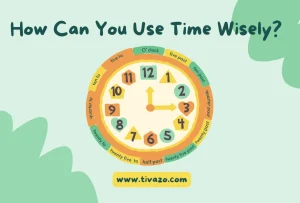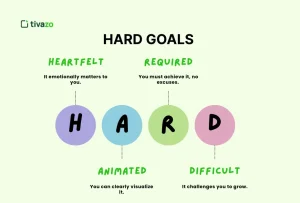In a work culture where every minute matters, we are constantly disrupted by notifications, conversations, and meetings that prevent us from being productive. Employees are interrupted every 11 minutes and it takes, on average, 25 minutes to return to focus. Quiet hours, one of the best strategies for teams, allow you to regain focus, reduce distractions, and get work done.
This article outlines ways to utilize quiet hours while going through psychological research, tools, industry examples, and tips for the hybrid workforce.
Key Highlights:
- Implement Quiet Hours in the Office
- 7 Powerful Ways to Focus Better
- Quiet Hours vs. Deep Work
- Quiet Hours in Different Industries
- The Future of Quiet Hours in Modern Workplaces
What a Quiet Hours
A quiet hour is a designated time in the workday when all non-essential communication (email, messages, meetings, etc.) is put on hold. It allows for an uninterrupted period of focus during work to improve employee engagement and productivity. It allows employees distraction-free work time and also allows deep work regardless of workplace type (busy offices or remote). When fewer distractions are present, it allows the team to have mental clarity during the day and complete more impactful work.
How to Implement Quiet Hours in the Office
- Choose consistent time slots (e.g., 10 AM-12 PM)
- Communicate the policy to the team
- Lead by example—managers need to follow it
- Use Slack/Teams status to indicate focus mode
- Block times on common calendars
- Set rules for urgent messages only
Get feedback and make adjustments
7 Powerful Ways to Focus Better
7 Powerful Ways to Focus Better are:
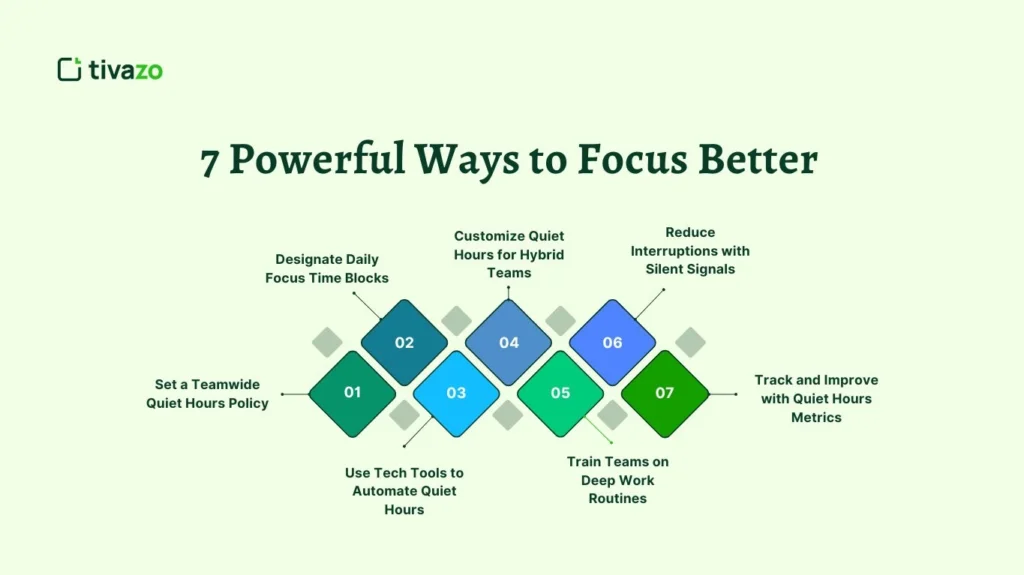
1. Set a Teamwide Quiet Hours Policy
Quiet hours are specific hours of the day when any non-essential communication, including Slack emails, or no meetings, is paused in an effort to create uninterrupted focus time for everyone. Starting with the easy-to-establish, set times such as 10 AM to 12 PM is your best bet, and making sure that is communicated effectively across the organization is the key. However, taking it on means demonstrating it as a priority, and leaders recognize it as important for their productivity as well.
To reduce the risk of incoming messages, there are two actions. First, communicate ahead of time and block off that time on shared calendars. Second, provide cueing on platforms like Slack or Teams about messaging during these hours regarding those urgent communications.
Using clear rules about what messaging would be considered urgent allows important things to be communicated without disrupting everyone’s quiet.
One marketing agency that implemented for all employees and stakeholders from 9-11 AM noted within a month they saw a 22% increase in task completion – a positive indicator that quiet time can work!
2. Designate Daily Focus Time Blocks
Our brains are not built to run constantly without barriers. We tend to cycle through periods of ultradian rhythm – roughly 90-120 minutes of really high focus, followed by an urge to rest. When work is scheduled on these natural bursts of energy, it makes all the difference.
As a guideline, schedule your most draining, details-heavy work times for the morning hours when our brains are sharpest, maybe 9-11 AM. Then schedule unusually creative or brainstorming tasks for the morning, perhaps 2-4 PM, where our energy dips a bit but inspiration can flow.
3. Use Tech Tools to Automate Quiet Hours
Technology may end up being your best friend when it comes to maintaining it. Tools help online distractions be used automatically.
For example, put Slack and your email on “Do Not Disturb” during your self-imposed quiet hours; this also stops the constant wave of notifications. Use your calendar with the ability to automatically decline any meetings during your quiet hours in an effort to eliminate surprises. You should also survey your team regularly to help finalize the timing of quiet hours in order to adapt to their ongoing work patterns in an effort to maximize their effective productivity.
These tools don’t just mandate quiet—they let your team take ownership of their focus and address decision fatigue.
4. Customize Quiet Hours for Hybrid Teams
Hybrid and remote work come with unique challenges — different time zones, diverse environments, and varied routines. Instead of one-size-fits-all, create asynchronous quiet hour windows that allow team members to engage during their peak hours while respecting others’ focus time.
In offices, establish quiet zones where employees can retreat for deep work. Remote teams can rely on platforms like Notion or Tivazo to stay aligned with quiet hours and collaborate smoothly.
A SaaS company that adopted async quiet hours saw Slack messages drop by 30% and doubled the output of deep work — demonstrating how thoughtful customization can create harmony across locations.
5. Train Teams on Deep Work Routines
To put it simply, deep work is focused and uninterrupted work that challenges employees mentally. It’s the secret sauce that leads to breakthroughs and meaningful work.
Encourage teams to use techniques such as Pomodoro (25 minutes of work; 5 minutes of rest), to create habits that will be sustainable. Using habit trackers, or applications that will reinforce these nice, simple habits, helps with natural integration into their workweek.
The Results? Teams who practice deep work during quiet hours have achieved productivity spikes of 20-25% and are challenging the work culture towards excellence and flow.
6. Reduce Interruptions with Silent Signals
Not all interruptions are associated with a ping or a call; rather, employees’ approaching or random conversations that arise have to be interrupted. To communicate when an end has been surrounded by silent interactions consider using silent signals. For example, desk flags, do not disturb on the door signs, or adopting a focused emoji status on chat apps communicate a needed, focused, uninterrupted block of time.
Creating a culture of valuing silence rather than isolation can help employees embrace these signals without guilt. Consider analyzing these wins in a public manner to exemplify the value of focus on deep work assignments. Also, help eliminate collaboration/connection by publicly scheduling brief meetings immediately upon quiet hour completion to establish a balance of silence and social connection.
7. Track and Improve with Metrics
To maximize quiet hours, you have to quantify what it brings you. Keep an eye on how many hours your employees spend in deep focus and see reductions in internal messages and the number of meetings in those time blocks.
Leverage dashboards from tools to see trends and draw insights. This data gives managers and teams the ability to iterate and improve on quiet hours so that they continue to adapt to changing workflows and remain valuable.
The Psychology Behind Quiet Hours
Our brains are wired for silence. Quiet environments allow your neural synapses to reach their full potential because neuroscience has shown that quiet leads to better neuroplasticity—the brain’s ability to create new connections—and helps us to remove clutter and think about things more substantively. When noise and constant interruptions are eliminated during your quiet hours, your brain is fully able to focus and absorb ideas.
Data also shows that the more we switch tasks, the more we interrupt ourselves, are tiring ourselves mentally, and are suffering from decision fatigue. It allows us to give our exhausted brains a rest from task-switching and interrupting ourselves throughout the day, thereby improving clarity of thought, problem-solving, and productivity for the entire day.
Quiet Hours vs. Deep Work: What’s the Difference?
The differences are:
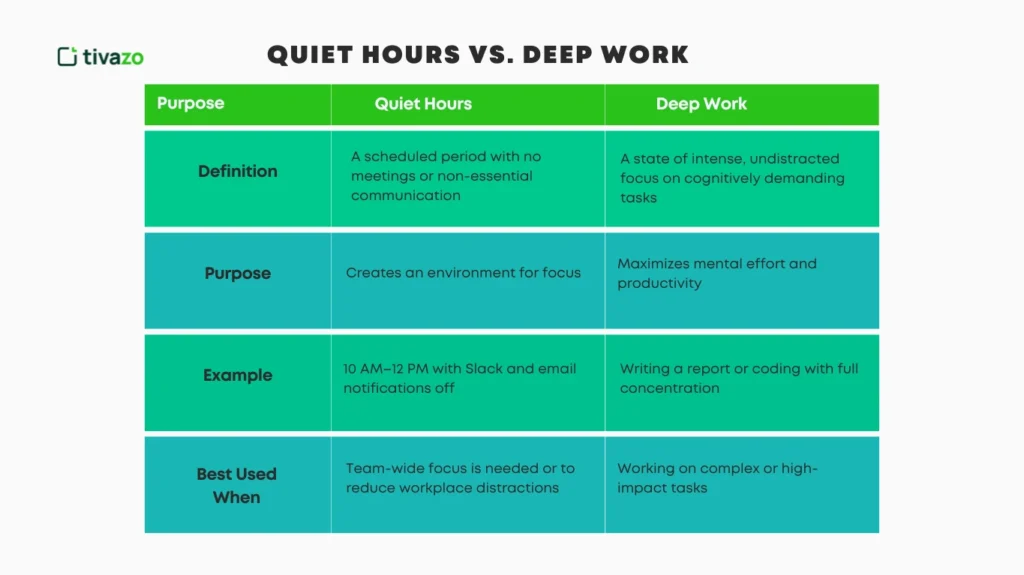
Quiet Hours in Different Industries
Tech, Law, Marketing – Custom Approaches
Marketing teams may want quiet hours at the start of the day, and tech teams may be better in the afternoon.
Frontline vs Knowledge Work
Frontline jobs can benefit from micro-quiet blocks, while knowledge workers can thrive in 2-3 hour blocks.
Key Benefits of Quiet Hours
Key Benefits of are:
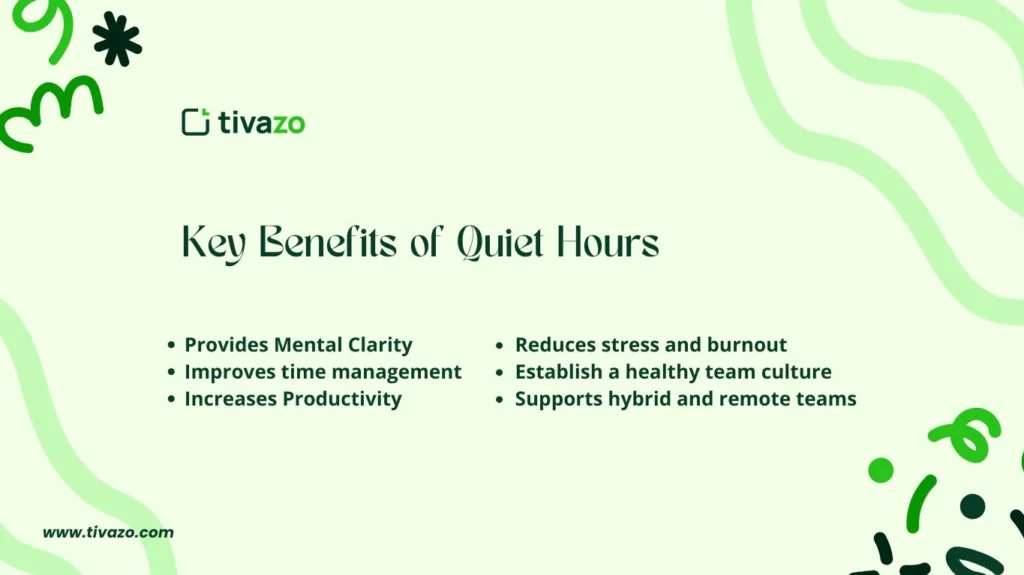
- Provides Mental Clarity – Reduces cognitive load through reduced task-switching.
- Improves time management – Supports batching and prioritizing daily tasks.
- Increases productivity – Teams report completing 25% more tasks during their quiet hours.
- Reduces stress and burnout – Removing notifications removes the feeling of burnout to respond immediately.
- Establish a healthy team culture – Define what to expect and prioritize focus as a team value.
- Supports hybrid and remote teams – It can be async, so theoretically it could be extended across time zones.
Balancing Collaboration and Quiet Time
Quiet hours are influential, but shouldn’t come at the expense of teamwork. A balance between focused solo work and open collaboration is paramount to long-term productivity.
Avoiding the “Anti-Social” Trap
One common concern is that it might make teams feel isolated or disconnected. The solution? Encourage short team sync-ups right after. These check-ins—whether daily stand-ups or quick virtual huddles—give team members a chance to reconnect, share updates, and clarify blockers. This keeps collaboration alive without disrupting deep work.
Meeting-Free Windows vs Quiet Hours
Meeting-free windows serve different purposes in the workplace and are, therefore, less useful together. Meeting-free windows do help you reduce Zoom fatigue and meeting scheduling chaos, but that is all they do; you can still receive chat messages, emails, or drop-in inquiries. Quiet hours, on the other hand, are more intentional; they are to stop all non-essential communication to sustain the ‘state of flow’. Together, they can be a fully focused strategy if you use them effectively.
When Collaboration Must Trump Quiet
There will be exceptions when launching a product, or responding to a crisis, and in times of high-priority moments, real-time collaboration is warranted. It is helpful to acknowledge these instances and communicate transparently about stopping quiet hours so everyone is aware. Quiet hours should be about productivity and not restricting productivity.
The Future of Quiet Hours in Modern Workplaces
The future of quiet hours is infinitely more exciting—and smarter! As AI productivity tools surge, workplaces will too, be able to dynamically schedule quiet hours based on not only individual patterns of focus and workload, team workload, and smart noise mapping of office noise. No more guesswork—just optimized focus time when your brain is naturally using its capacity the best it can.
Workplace trend reports from SHRM and Gartner predict that it will rapidly transition from a novel idea to formalized company policy, as more organizations demonstrate measurable gains in output and employee well-being, and simply humans residing on this continuum. When coupled with the new ways of working like a 4-day work week, it could completely change how we consider work—fewer meetings, consistent progress, and actual work/life balance for everyone.
Conclusion: Make Quiet Hours Your Secret Weapon
Quiet hours are a research-based, practical advancement to support focus, reduce burnout, and improve your team culture. An intentional quiet period might just be that day’s secret weapon—starting with one quiet span tomorrow can reduce burnout and dramatically alter your workplace culture. Silence is good; measure the results, and watch it thrive. Try a quiet hour tomorrow; measure the difference. Let me know how you did.
FAQs
What are quiet hours in Washington State?
In most cities in Washington, quiet hours are from 10 PM to 7 AM on weekdays, and 11 PM to 8 AM on weekends.
What are the legal quiet hours in Oregon?
Oregon generally enforces quiet hours from 10 PM to 7 AM, but exact times may vary by city or county.
What are quiet hours in San Antonio?
San Antonio’s noise ordinance defines quiet hours from 10 PM to 6 AM, especially in residential zones.
What time do I have to start being quiet?
Typically, quiet hours begin at 10 PM, but check local laws as times may differ by region.


